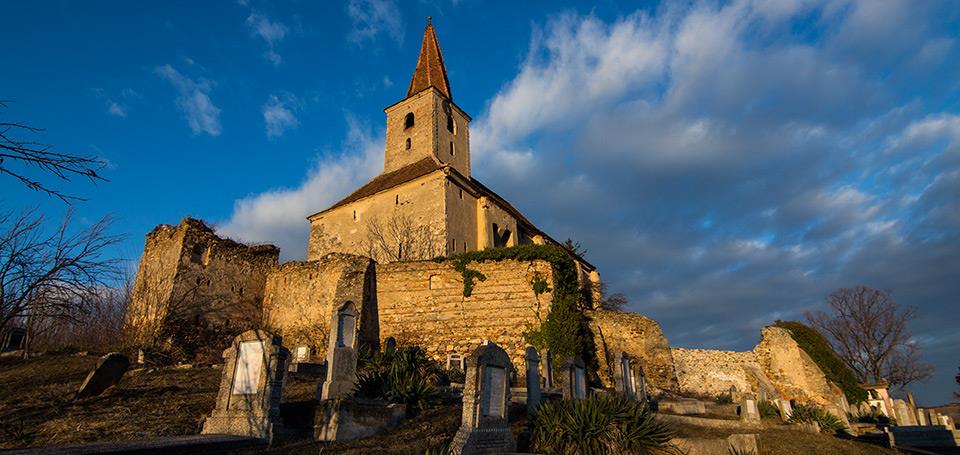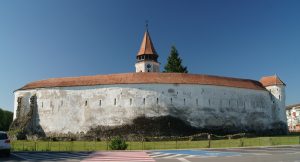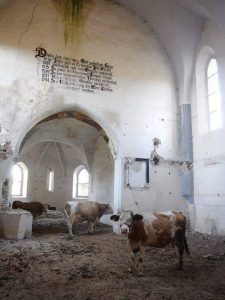The South-eastern part of Transylvania is renowned for its fortified churches built since the 13th century. These served as a defence form until the last Ottoman incursion into Transylvania, 1788. The fortified churches are specific to the Saxon and Szekely villages located in this area, and are part of the European phenomenon of fortified churches.

Dobarca – Photo by Alexander Kloos
The Transylvanian fortified churches can be categorized by the type of fortification into three main groups: fortified churches, churches with fortified enclosure walls, and churches with mixed defensive features (“church-fortress”). The first category can be recognized by the belfry towers which were turned into a donjon (keep) or thick walls which had large paths for guards with holes in the floor, and under the cornice there were mortars. The second category sees the churches’ building without a defensive element. They are surrounded by walls, which in some cases can be either relatively small, without crenels, and few defensive towers, or on the contrary, tall and thick with guard paths, several towers, and crenels. Other types have multiple enclosure walls. Finally, the last category presents the fortifications that have a combination of the two previously mentioned types. It can be seen as a double protection system. Besides the use of the church building designed as a defensive structure, there are also the surrounding walls having multiple defensive elements.

Some of the churches were equipped with enclosure walls that could handle prolonged sieges. Within these walls the entire population of the village could be sheltered in the spaces that were used as barns in peacetime, and each family had its own room.
The churches received various changes over time, including the defensive function. All of them are either Romanic basilicas or single ship churches built in the late Gothic style. Some of them have interior decorations of precious Gothic narrative frescoes which can be traced back to the middle of the 14th century.
From their construction during late Middle Ages until the end of the 16th century, the majority of churches have had numerous alterations and additions. They played both a religious and a military role for more than five centuries. But in some of the cases, the defensive elements of the enclosures (towers, walls) were partially or totally demolished in the last three centuries (especially in during the 19th and 20th centuries), as they had not fulfilled their role anymore.
Once 300, now about 150 buildings form one of the densest medieval fortification systems very well maintained on the European continent. Many of them have been conserved until today and play an important part within a unique landscape, especially through the density and variety of monuments. These have become the hallmark of many villages and the region in general.
The fortified churches have been for centuries the religious and cultural centre of rural communities, being built, used and maintained largely by Transylvanian Saxons and Transylvanian settlers. Sadly, in the last few decades most of the Transylvanian Saxons have left the region. Thus, a question is raised concerning the future of these fortified churches, a universal heritage, which is part of the UNESCO World Cultural Heritage.

Dobarca – Photo credit Lutz Connert
An interesting study case is the Dobârca’s (Romanian: Dobârca; German: Dobring, Dobreng; Hungarian: Doborka) Evangelical Church, Sibiu County. Once a ravishing edifice, this historical heritage monument is collapsing little by little. The church was built in the 13th century as a basilica with three naves, a bell tower and a loft.In the year 1481, the newly added Gothic elements transformed the church. At the beginning of the 16th century there were works which turned the place of worship into a fortified church, having the old Romanic tower being embedded in a defensive tower. The works had several phases. The 14th century fortified area with the circular courtyard around the worship centre and with a tower at the entrance is being reorganized. With the fortification works, the massive western tower is lifted, this bringing it necessary to demolish the old courtyard and widen it westwards with polygonal twin towers. This phase was completed in 1515. Then, at the beginning of the 17th century an arched tower was built in front of the old one. In 1741, the last major restorations of the architectural ensemble took place. After 1989, the place was abandoned when the Saxons started to emigrate. With the vandals that destroyed most of it, it began its advanced state of degradation. The interior has been completely ruined. The windows were broken, the floor was dismantled, the altar desecrated, and cracks appeared in the walls threatening the integrity of the building. Recently, the church tower bell has been stolen in order to be sold at the old iron collection centres. Even in the cemetery near the church, the marble crosses on the tombs have been broken.
These heritage monuments bring a glimpse into the past that has long been lost. They will still have this role for future generations only if we are aware of their value.
Author: Architect Mara Popescu, PhD, MSc., MA.
KU Leuven
BIBLIOGRAPHY:
- Ţiplic, Ioan Marian, 2002: 800 de ani Biserica a Germanilor din Transilvania, Sibiu, Wort und Welt, Muzeul Brukenthal
- Anghel, Gheorghe, 1972: Cetăţi medievale din Transilvania, Bucharest, Meridiane Publishing House
- Bârcă, Ana et all, 2013: Romania: UNESCO Monuments, Bucharest, Noi Media Print, ISBN: 978-606-572-020-6
- Rossel, Hubert, 2015: “Les églises fortifiées du pays des Sicules”, Cluj-Napoca: Maison d’Edition Risoprint
- http://adevarul.ro/cultura/patrimoniu/patrimoniulvandalizat-biserica-evanghelica-fortificata-dobarca-jud-sibiu-1_526d88afc7b855ff5688a895/index.html
- https://povestisasesti.com/
- http://adevarul.ro/locale/sibiu/video-foto-biserica-fortificata-dobarca-monument-patrimoniu-aproape-darama-1_52833eb8c7b855ff56ed8a0b/index.html





Follow us: